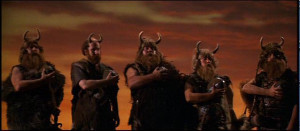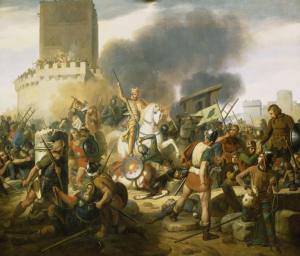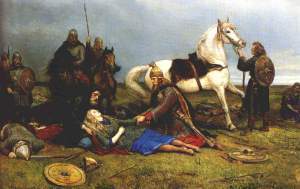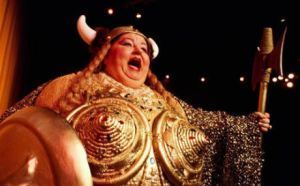The Allure of the Vikings

The world has produced many civilizations worthy of close study and adoration, but none have done so quite as serendipitously as the Vikings. All curricula of schools of Western countries include some mention of the Vikings, whether it be a small albeit interesting footnote about the Middle Ages, or a more in-depth analysis of their activities in countries such as France and England. Regardless of the depth, the mere mention of them tends to be entrancing to all who first encounter them. This all begs the question: What lends to their appeal?
The answer: The Vikings have classically been the Antagonists of history. Their demise was used as the symbol for the triumph of civilization over the “Noble Savage.”
For most, the Vikings are a mysterious people. Not everyone has the time to study their culture and history in depth. What they know of the Vikings comes from popular culture snippets such as those offered by the History Channel or the BBC. In this light, they are portrayed as a barbaric group who savagely carved their way through Christendom leaving a trail of destruction in their wake. The Vikings have thus earned an appeal as frightening figures in history capable of giving a good scare. They make excellent antagonists in fictional stories and their reputation is effective at stirring the emotions of those who see or hear those stories. That is their allure today, as made evident by the plethora of Viking-themed media.
This reputation for bloodlust and violence we have today stems of course from another source. Beginning in the 19th century, historians began to explore the history of the Vikings in more depth. The sources they had to formulate their arguments for the structure of Norse society were primarily the writings and chronicles of Christian writers. These writers did not paint a positive light of the Vikings who often raided monasteries for their riches. This would all have been for naught if the political climate in Western Europe in the 19th Century had been different. Unfortunately for the Vikings, Europeans were in the full swing of their imperial exploits, desiring to achieve wealth and to spread their culture across the globe. As historians produced more works about the Vikings, the people of Europe began to read them, and in doing so began to shape their views of the Vikings through the cultural lens of their time.
Seeing the Vikings as savages from the north, the Christians of the 19th century saw an opportunity to make a historical analogy to the conquests of the day. In America, the European immigrants on the East coast were pushing west as part of their “Manifest Destiny” and encroaching on the lands of the Natives already living there. Similarly, European settlers in Indonesia, Australia, Africa, and South America were attempting to reconcile their bellicose takeovers of their new lands with the decimation of indigenous human populations. Alas, they found their shining example from history which they could use to justify their exploits: the Vikings. In the Vikings they saw savages akin to those they met in far-off lands. Yet despite this dehumanizing categorization of an entire population, they recognized them as having a moral code, or a code of honor. Thus was born the idea of the “Noble Savage.”
The Vikings were savages who threatened the “civilized” peoples of Europe for over a century. In the end they were brought into the fold and converted to Christianity for their own betterment. This was the narrative to be used and applied to encounters with other hostile peoples across the globe. In the United States, the “Noble Savage” ideal was applied to the Plains Indians who to this day are woefully the most overused exemplification of Native Americans whose true cultural complexity is mostly lost on a majority people. As the idea of the Noble Savage proliferated European culture, so did the Vikings. Suddenly, there were books, plays, and even entire symphonies dedicated to the Noble Savages of Scandinavia, not the least being Richard Wagner’s “Ring of the Niebelung.” It was in the production of this opera in Berlin in 1889 that the Vikings earned their horns which were an invention of the opera’s prop manager.
Noble Savages were the antagonists to civilization. Their demise was used as the symbol for the triumph of civilization over the “Noble Savage.” Europeans unashamedly considered themselves more civilized than the peoples they encountered across the globe and thought it their duty to bring those people into the fold of their worldview. One need look no further than Rudyard Kipling’s “The White Man’s Burden” for evidence of this. The Vikings were used as a metaphor to spread these ideals and to justify them. We now know that the Vikings were not necessarily the bad guys (although they did a lot of bad stuff—but who didn’t in those days?). Historians are increasingly realizing that the true villains during the Viking Age were in fact the “civilized” peoples. There is no truer statement than “history is written by the winners.” This unfortunately is how the Vikings earned their reputation and came to have such an allure to society. Today there is much revision being conducted in the field of Scandinavian history. Their story is being rewritten outside the narrow vision put forth by scholars of the 19th century. Increasingly, people are beginning to view the Vikings less as Noble Savages and more as the complex, culturally rich people they actually were. This same assertion is true for the study of many cultures around the world. It is an exciting time to learn about the Vikings for there seems to be new discoveries every day which are adding to our breadth of knowledge of this previously under-understood people in history. For now, however, the idea of the “Noble Savage” is still the most alluring aspect of them to the majority of people.









